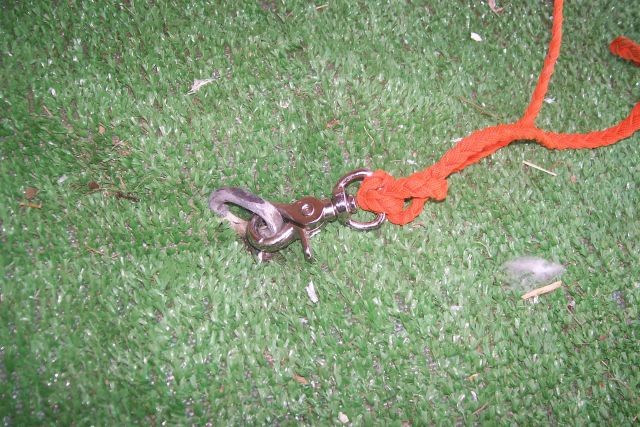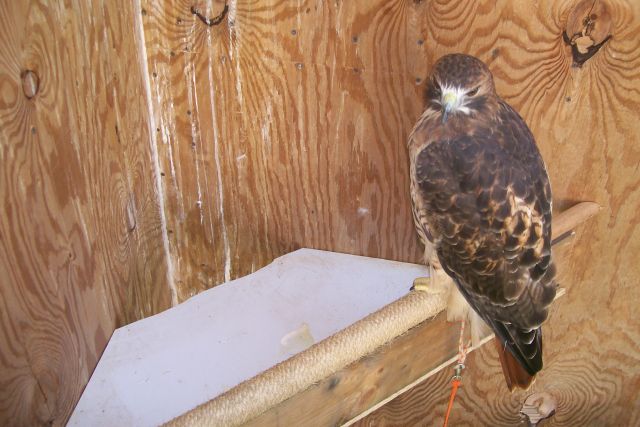I found this fine article in fall 2008 edition of On The Wing. It was contributed by Jimmy Tomkins, who flies RT's and Harris' hawks in Georgia. This tethering concept is a fantastic idea, and should be the standard for tethering in a mew. I talked to Jimmy; he allowed me to post this article on my web site.
Jimmy contributed a tiercel Harris' hawk from his breeding project and raised $1000 for Chris Comeaux, after Chris' house was heavily damaged by Hurricane Ike in September of 2008. Thank you, Jimmy.
Note Added November of 2014: The corner perch must be installed in a blind corner as shown below i.e. you do not want bars and screen behind the perch or it will diminish the value of the system. Especially with a new hawk, you don't want her trying to escape behind the perch when you approach. Also the hawk will slice into the screen sometimes, fouling it.
Tethering in an 8x8 Mews
by Jimmy Tompkins – Loganville, GA.
www.outlawhuntinghawks.com
It seems that all over the country, 8x8 is the recommended minimum size for a mew. In fact, it’s the minimum required by law in a lot of states. If free-lofting your bird, that is just big enough to provide several different perches in different locations, and allow the bird room to move around. However, if you wanted to tether your bird, it can be a bit tricky to safely do in a smaller area of this size. If you go the traditional way of using a bow perch, or a ring perch, you have to be careful. You usually end up with the perch in the very center of the mew, and if you have a larger bird, such as a nice sized female red-tail, you often have to short leash them so that they don’t hit the walls when they bate. When you add a bath pan to the equation, it only serves to make things worse. With the bird being short leashed, the bath pan must be right beside the perch, otherwise the bird can’t reach it. With the bath pan so close, if the bird bates in that direction, he/she winds up in the drink. I won’t even mention the times when the bird manages to tangle it’s leash on the perch that you thought was tangle proof……..
The following pictures and descriptions are how I get around these problems in my 8x8 mews. Rather than use a traditional bow perch, my birds are tethered in a corner.
I have a wooden dowel, wrapped with sisal rope, secured diagonally in the corner. I’ve been meaning to add daisy mat to half of the perch, to give another surface option. But being the slob falconer that I am, I just haven’t gotten around to it….. The perch is 4 feet wide and approximately 36 inches from the ground. Underneath the perch, I have what amounts to a shelf. This is here so that the bird can’t go over the perch, and come back up from underneath, tangling itself and being wrapped around the perch. The shelf is made from a 2x6 that is 48 inches wide, and is placed an inch or two below the perch. Attached to the bottom of the 2x6 is a triangular shaped piece of ½ inch plywood that fits into the corner. I cut a small piece out from the back of the triangle, so that most of the mutes will hit the wall, and slide down from there, rather than building up on the shelf. I also cut a piece of CoroplastTM that fits inside the shelf. This makes cleaning a little easier, as you can simply take the CoroplastTM out and scrape it, and hose it off.
The anchor point of the leash is on the ground, directly under the center of the perch. It is nothing more than an eye bolt that I welded to a steel spike, and drove into the ground. They make a similar thing for tying dogs out that would work equally well. Hooked to the eye bolt is a “swivel snap” where the leash is secured. This gives another swivel point which helps eliminate leash tangles. Now I know a lot of you have probably been told never to use these on a bird, as they may fail. The fact is that these are a LOT stronger than you think they are. I would never secure a bird with one of these outside of the mew, but they’ll work just fine inside the mew. Traditional mews jesses and a Sampo swivel are used on the bird. The bird is given just enough leash to sit on the perch, with a small amount of slack. At first glance it may seem like the bird has too much leash, but that really isn’t the case. Because the bird is already at the full length of the leash when/if it bates from the perch, it simply pendulums down in an arc, with little shock to the legs. Bating from a more traditional set up is actually worse on the bird, as there is slack in the leash before being jerked to a stop.
The bath pan sits off to the side. It’s close enough to easily reach without running out of leash, but far enough away that it doesn’t get filled with mutes. It has the front edge covered in daisy mat. Not only is it a nice place to get a drink or take a bath, but the birds also use it as a 2nd perch. So it now serves an extra purpose.
The floor is covered with interlocking foam exercise mats, with cheap indoor/outdoor carpet laid over them. Talons stay sharp, and I’ve had no feather issues. We’ve all seen how a bird at weight will often bate towards the falconer on approach. Because this perch set-up is on the opposite corner from my mew door, there have never been any issues with my birds raking their wings against the wall. They rarely bate at all, but when they do, it is always towards the center of the mew where there is nothing to hit.
So for those of you that are looking for a different way of tethering, give this a shot. I don’t think you’ll be disappointed. I’ve kept numerous red-tails and Harris hawks housed this way, and can’t think of one problem that has come from it.

View of hawk sitting on perch 36" from floor |

Method of attaching leash to spike and eyebolt driven deep into ground |

View showing shelf, notch, and CoroplastTM sheet |
|
|

